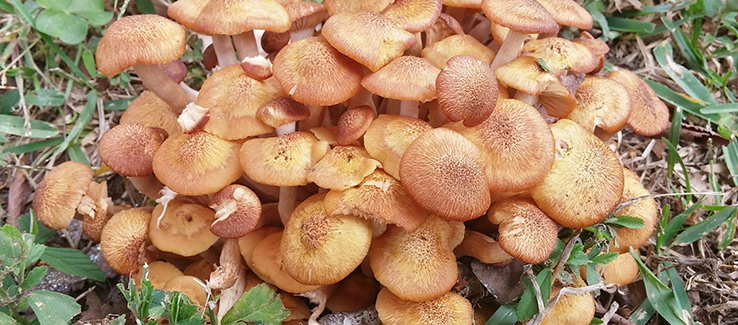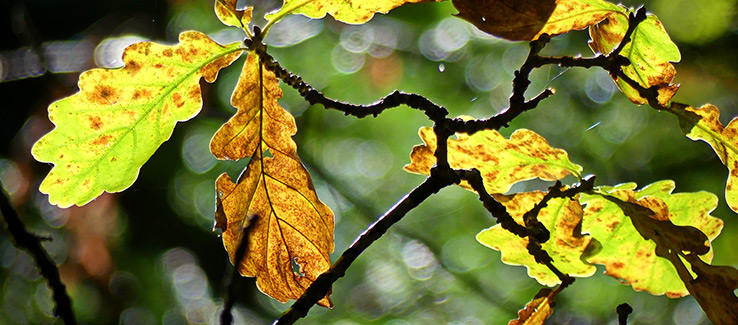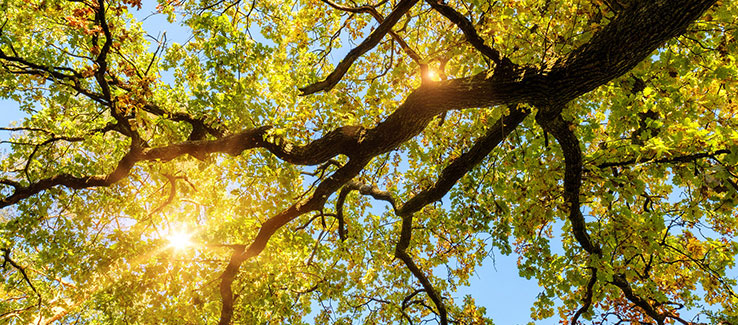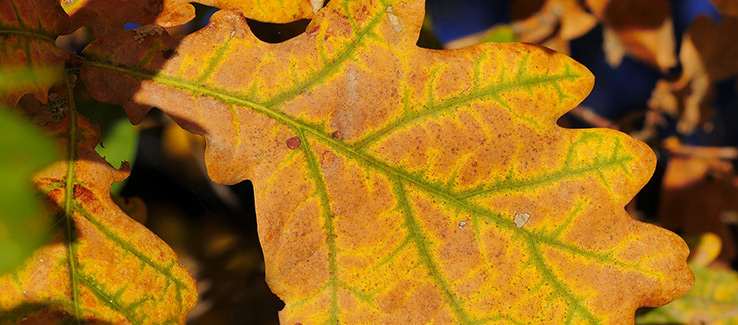9 Oak Tree Diseases Identification and Treatment
Prevent catastrophic damages or injuries when disease causes your oak tree to die and fall. Knowing how to identify and treat oak tree diseases will help you keep your oak trees healthy and thriving.
fasttreeremovalatlanta.com gathered information on nine oak tree diseases, dying oak tree symptoms, and how to treat them before they get out of control.
Armillaria Root Rot

Armillaria root rot is caused by multiple species of Armillaria fungi. This disease causes slow or poor growth, chlorotic foliage, and the tree’s eventual death. Armillaria root rot can infect many deciduous and evergreen tree and shrub species. Trees infected with Armillaria root rot will have decayed roots and lower trunk. In trees with advanced infections are very likely to suffer windthrow or windbreak in storms.
Armillaria Root Rot Identification
Most of the damage caused by Armillaria root rot occurs below ground. However, these signs can indicate the disease’s presence:
- Foliage emerges small or chlorotic (deciduous trees)
- Dieback in upper portions of the crown
- The tree may produce a stress crop (abnormally large production of seeds)
- Large groups of light-colored mushrooms grow at the base of the tree or on the root flare
- Thick, black fungal strands may grow in a net on infected trees and in the surrounding soil.
- The tree will eventually die
Note: Any time mushrooms or conks are growing on a tree, it is cause for concern. Mushrooms require decaying material to grow and survive.
Armillaria Root Rot Treatment
The first line of defense for your trees is their health. The more optimal their conditions are for healthy growth, the better their chances are of remaining disease-free. Accomplish this by:
- Mulching the soil around the tree’s base
- Increase the tree’s watering schedule during drought
- Protect trees from mechanical wounding (lawnmowers, weed whackers, and other equipment) Prevent foot and vehicle traffic from the tree’s root plate to prevent soil compaction
- Remove unstable trees
- Remove infected stumps and as many of the roots as possible
Tip: Have your trees assessed by a certified arborist to determine if they are infected with Armillaria fungi and determine their structural stability.
Oak Leaf Blister (Oak Leaf Curl)
Oak leaf blister is a fungal leaf disease caused by the fungus Taphrina caerulescens. During cool, wet growing seasons (spring), nearly all oak species are subject to this disease.
Oak Leaf Blister Identification
This disease displays itself very conspicuously by:
- Producing yellowish-white circular, raised areas (blisters) on upper leaf surfaces
- Likewise, producing a yellowish-brown depression (same size) on the lower leaf surface
Note: In cases where the disease is advanced, defoliation may occur. Leaf loss in early summer will sometimes result in a second leafing out in the same season. When defoliation occurs in late summer, the tree will not likely leaf out again until the following spring.
Watch this video to see examples of oak leaf blister.
Oak Leaf Blister Treatment
Unless your tree is growing under stressed conditions or has suffered multiple disease infections, oak leaf blister should not severely affect the overall health of your tree. However, this and other diseases should be treated to avoid weakening your tree’s health.
A single fungicide application in early spring at the time of bud-swelling (before bud break) should be adequate to curb oak leaf blister. You can apply a fungicide appropriate for Taphrina caerulescens with a power sprayer, thoroughly coating buds and twigs.
Chlorothalonil is an organic compound used as a broad spectrum, non-systemic fungicide recommended for controlling oak leaf blister.
Tip: Fungicide treatments lose their efficacy when applied after bud break.
Bacterial Leaf Scorch (BLS)
Bacterial leaf scorch is a tree disease caused by Xylella fastidiosa, which invades the xylem of susceptible trees. Leafhoppers and spittlebugs spread BLS from tree to tree by feeding on its xylem.
Bacterial Leaf Scorch Identification
Similar to oak leaf blister, BLS symptoms appear in the tree’s crown and are highly noticeable. Here’s what to look for:
- Leaf margins turn brown
- Signs appear on older, inner foliage and move outward to newer leaves
- In most cases, browned, dying, or dead areas of the leaf are strikingly separated from green tissue by a yellow border
Note: Defoliation should not be used as an identification method as leaves may or may not drop after infection and death.
Watch this video to see the symptoms of bacterial leaf scorch.
Bacterial Leaf Scorch Treatment
As of now, there is no cure for bacterial leaf scorch. While diseased trees can persist for several years, they will eventually die. The following practices can extend the life and healthy appearance of your tree:
- Seasonal pruning – remove dead wood
- Watering practices – increase tree waterings during summer months or during drought
- Antibiotic treatments – antibiotic injections containing oxytetracycline
- Tree removal – Remove infected trees and replace them with disease-resistant cultivars
Once your tree has burned leaf tips or margins, there’s no damage reversal at that wounded location. The only course of action is to prune out problem areas and encourage the tree’s healthy growth.
Note: The use of antibiotic injections may cause a temporary remission of symptoms but does not cure BLS.
Leaf Spot
Leaf spots can be caused by air pollutants, insects, and bacteria. Most are a result of infection by pathogenic fungi. Once inside the leaf, fungi continue to grow, and leaf tissue dies. Leaf spot fungi are most prolific during cool, wet weather in early spring. Leaf spot diseases are rarely a problem after warm, dry spring weather.
Leaf Spot Identification

Leaf spot occurs in the mid- to late spring months through the summer months, with irregular, dark brown spots developing between leaf veins. Trees with iron chlorosis or subject to other stressors (drought, infestation, disease, etc.) are likely to develop leaf spot.
Leaf Spot Treatment
While extremely unsightly, leaf spot is rarely lethal to trees and shrubs. Here are some simple measures to minimize or prevent a leaf spot outbreak:
- Remove and destroy fallen leaves in the fall. The causal fungi or bacteria overwinter in fallen leaves.
- Avoid overhead watering, spraying, and splashing.
- Prune your trees with clean and sanitized equipment.
Chemical control should only be used as a last resort or when your trees are stressed from other diseases or pests. Consider the following:
- If your tree’s leaves are already out and showing signs of leaf spot, chemical control will be ineffective. Wait until next spring.
- Apply fungicide as buds swell in early spring.
- Follow up with another fungicide application five to ten days after bud break.
- A third application may be needed during a rainy spring.
To keep leaf spot from spreading, use a fungicide containing the active ingredient propiconazole. For those reluctant to use chemical control methods, spray with a mild solution of bicarbonate of soda (baking soda) instead.
Note: The additional stress of leaf spot on an already distressed tree may result in permanent injury or death.
Oak Wilt
This fast-spreading lethal oak tree disease is caused by the pathogen Ceratocystis fagacearum. Oak wilt disease moves from tree to tree by the wood-boring oak beetle (Agrilus auroguttatus) or root grafts (underground roots connected between trees).
Oak Wilt Identification
The progression of oak wilt in red oak cultivars is swift, and the following symptoms indicate the tree’s impending death.
- The tree starts to die from the top down.
- Leaves will turn a pale green, wilt, and then suffer bronzing or tanning along the edges and inward to the main vein.
- Leaves may droop, roll lengthwise and wilt.
- Leaves may also die from the tip down.
- As the disease progresses down the tree’s canopy, upper leaves will turn yellow and fall off. Green leaves will fall off too.
- As the infection spreads, brown streaks develop in the sapwood.
Note: Streaking caused by the oak wilt fungus occurs as vascular tissue is plugged by chemicals produced by the tree – to stop the disease.
The progression of oak wilt in white oak cultivars is much slower, as these trees are more tolerant to the disease. They can become infected and persist for many years.
Watch this video for more on oak wilt.
Oak Wilt Treatment
The most effective oak wilt control measure is prevention. There is no treatment method to cure infected trees. Trees and their roots infected with oak wilt should be professionally removed and destroyed (preferably by fire) before the disease has a chance to spread.
Oak Anthracnose
Oak anthracnose is caused by a fungal pathogen called Apiognomonia errabunda (previously known as Apiognomonia quericina and Discula quercina)
Anthracnose infections typically begin in the lower canopy and progress upwards. This is because shade and moisture are more readily available in the lower canopy. Some infected foliage – on many oak species – will persist in the canopy over the winter months. Infection of newly developing foliage occurs the following spring.
Oak Anthracnose Identification
Anthracnose symptoms initially appear on foliage as being water-soaked, blighted, or as blotches along veins as new foliage develops.
As the disease develops, lesions dry, becoming gray-colored. Newer foliage can become distorted or shriveled, and defoliation may occur.
Mature foliage is more resistant to this disease. Having developed a thick, waxy cuticle, wounds on these leaves are often smaller.
Apiognomonia produces most spores asexually from fungal pads that rupture through the leaf’s surface and petiole. The fungal pads (acervuli) appear on the upper or lower surface of the leaves, along the veins.
Twig dieback may lead to secondary colonization by wood-boring insects and/or stem cankering fungi like Hypoxylon canker.
Disease outbreaks tend to subside by mid-summer (warmer & drier conditions). When cooler, wetter weather returns, a resurgence in disease development may occur.
When oak trees are weakened by other stresses, like boring insects, Armillaria root and butt rot, oak anthracnose symptoms can be amplified.
Watch this video to see how anthracnose can be identified.
Oak Anthracnose Treatment
A well cared for, and regularly fertilized Oak tree can develop a resistance to Anthracnose. There are many ineffective ways to treat oak anthracnose. However, fungicide applications performed by an arborist provide the most efficacious results.
In cases where 15% or more of the tree’s canopy has been lost or must be pruned, your arborist will likely recommend tree removal to prevent the disease from spreading.
Hypoxylon Canker
Biscogniauxia (Hypoxylon) atropunctatum quickly colonizes stressed trees. The Hypoxylon fungus is an opportunistic pathogen, and vigorous trees are ordinarily unaffected. Hypoxylon canker can affect any type of oak, including:
- Black (Quercus velutina)
- Blackjack (Quercus marilandica)
- Laurel (Quercus laurifolia)
- Live (Quercus virginiana)
- Post (Quercus stellata)
- Southern red (Quercus falcata)
- Texas red (Quercus buckleyi)
- Water (Quercus nigra)
- White oaks (Quercus alba)
Note: This disease occurs on trees in many habitats like forests, pastures, parks, urban and suburban green spaces, and areas in development.
Hypoxylon Canker Identification
This disease appears as a dead lesion (canker) on limbs, branches, and trunks. The canker develops under the bark and eventually causes a white rot decay of the inner sapwood. This decay contributes to the tree’s mortality and renders the tree a significant danger to life and property. Consider the following symptoms:
- Chlorotic (yellow), then brown leaves
- Small stunted leaves and reduced twig growth
- Thinning canopy
- Dieback
- Water sprouts (epicormic shoots) growing on surface roots, trunks, and large limbs
- Dieback of feeder roots
- White/stringy sapwood in the cankered area
The signs of the fungus include:
Early stages – Dark reddish-brown to olive-green shades of crusted fungal (stroma) tissue over the cankered area.
Later stages – Grey surface that eventually flakes off after 6 to 12 months to reveal a brown to black crusty material displaying a burnt appearance.
Advanced stages – Smaller cankerous patches merge into large vertical strips along the trunk and major limbs of the affected tree.
Watch this video to see what hypoxylon canker looks like.
Hypoxylon Canker Treatment
No known fungicides are available to cure or prevent Hypoxylon canker. Therefore, managing this disease depends more upon maintaining vigorous, healthy trees and preventing the contributors that lead to decline and stress. Healthy trees can resist this pathogen.
If a tree exhibits signs of stress, take prompt measures to reverse the condition before this, or a combination of pathogens can colonize the tree. Here’s how to deal with this disease when it appears on your oak:
Hypoxylon Canker present on Limbs and Branches – When this infects the limbs and branches (not the trunk) of a tree:
- Infected limbs and branches should be carefully and completely pruned from the tree.
- Prune infected limbs and branches in sections if needed to minimize disturbing infected areas.
- All wood infected by any species of fungi should be handled as highly transmissible to surrounding trees and shrubs.
- Never run these limbs and branches through a wood chipper.
- This wood should be burned.
Hypoxylon Canker on Tree Trunks – When this disease has infected and appears on the tree trunk, there are no actions to prevent the decline and eventual death of the tree:
- Hire a tree service to carefully remove the tree.
- Never run a Hypoxylon canker infected tree through a wood chipper.
- This wood should be burned.
Tip: Hire an arborist to evaluate, treat, and remove (when necessary) an oak tree infected with Hypoxylon canker disease. They are trained to handle such cases without spreading the disease.
Powdery Mildew on Oaks
There are many different species of powdery mildew causing fungi, and each species attacks a diverse range of trees and plants.
When powdery mildew begins to take over a tree or plant, a layer of mildew (made up of numerous spores) forms across the top of the foliage. These spores can then be carried to other plants by the wind. Powdery mildew can result in slowed growth and compromised fruit yield/quality when severe enough.
Powdery Mildew Identification
Powdery mildew is a simple disease to recognize. The first sign of infection is usually white, powdery spots or patches on the top side of leaves or on plant stems. Infected leaves turn yellow and twisted. Then, once the infection strengthens, new shoots and buds will develop with distorted growth.
For more on powdery mildew, watch this video.
Powdery Mildew Treatment
Here is how you can regain control when powdery mildew attacks your oak tree:
- If possible, reduce or completely eliminate summer watering.
- Let spring growth harden off (mature, expanded leaves are very resistant to this disease).
- During the dormant season, prune out any “witches brooms” that formed during the growing season.
Tip: While summer drought is the best control, you can apply a chlorothalonil, sulfur, or copper-based fungicide during the winter months. If multiple applications are required, alternate between fungicides to prevent disease resistance.
Lichen
Lichen are unusual organisms composed of a fungus and an alga and/or a cyanobacterium symbiotically living together. The alga converts sunlight and carbon dioxide in the air to carbohydrates. The fungus surrounds the alga, protecting it from drying, and in turn, lives off of the food it provides.
Lichen Identification
Identifying lichen can be much more complicated than identifying vascular plants. Each lichen thallus is a complete microscopic world with unique characteristics separating it from other lichen.
When identifying lichen, keep in mind that one species of fungus can have two different forms if paired with two different “photobionts.” It is not common, but it does happen.
Lichen can appear green to gray-green leafy or crusty growths on the trunk and branches of trees typically in poor health.
Watch this video for more lichen information.
Lichen Treatment
Lichen will gradually disappear as tree health is restored – as foliage thickens, less sunlight gets to the lichen, inhibiting them from producing food.
Products containing copper sulfate sprayed on lichen will kill the fungus portion of the organism. Copper-sulfate is best used as a treatment for tree lichen from late spring through early fall. Such applications are not effective in cooler weather.
Note: Lichen pose no severe threat to trees. One of the ways lichen directly benefit humans is through their capacity to absorb everything in their atmosphere, especially pollutants.
Disclaimer: As with any/all chemicals, carefully read and follow the manufacturer’s directions/instructions before handling them or hire an arborist for such applications.
Tips for Caring for Oak Trees
Oak tree neglect can lead to a tree limb falling on a car, or worse, an entire tree falling on your house. However, if you properly care for your oak tree by pruning it, using oak tree fertilizer, and watering it the correct amount, you will help your tree remain healthy and better able to stave off harmful diseases.
The following are tips to help you better care for your oak tree:
- Provide your oak tree with full sun
- Provide your oak tree with well-drained soil Deciduous oak trees need regular pruning
- Mature oaks only need pruning to remove dead or weakened branches
- Young oak trees need fertilizer for growth, while mature oaks need fertilizer for health
- Avoid mechanical injury to your oaks during favorable conditions for infection (typically in spring and early summer)
- Apply tree wound dressings or paint when out-of-season pruning must be performed to prevent disease transmission.
If you’re handling oaks compromised or killed by oak wilt, root rot, or other diseases, remove and properly destroy them to prevent infecting other oaks.

Common Oak Tree Diseases
In this article, you discovered information on several oak tree diseases, how to identify them, and how to treat them before they get out of hand.
Knowing how to identify and treat oak tree diseases will enable you to take swift action to stop the disease and prevent the decline or death of your oak tree.
Allowing diseases to develop without control measures further weakens a tree’s defenses allowing multiple pathogens to successfully attack, debilitate, and kill your tree.
Sources:
extension.umn.edu/plant-diseases/armillaria-root-rot
missouribotanicalgarden.org/gardens-gardening/your-garden/help-for-the-home-gardener/advice-tips-resources/pests-and-problems/diseases/fungal-spots/oak-leaf-blister.aspx
plantpathology.ca.uky.edu/files/ppfs-or-w-12.pdf
ladybug.uconn.edu/FactSheets/leaf-spot-disease-of-trees-and-shrubs.php
fs.usda.gov/treesearch/pubs/18481
web.extension.illinois.edu/hortanswers/detailProblem.cfm?PathogenID=281
agrilifeextension.tamu.edu/library/landscaping/hypoxylon-canker-of-oaks/
ceventura.ucanr.edu/Gardening/Coastal/Landscape_578/Viruses_Menu/Mildew_on_Oaks/
hgic.clemson.edu/factsheet/oak-diseases-insect-pests/
(404) 220-9965
(404) 220-9963

